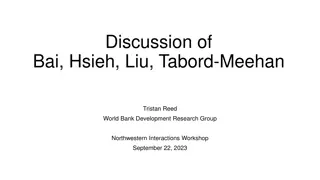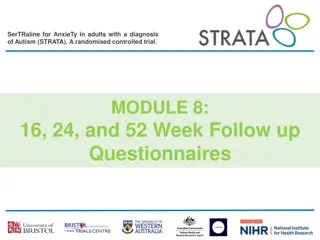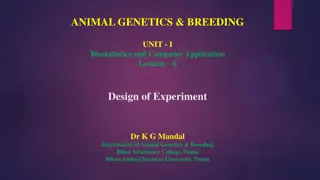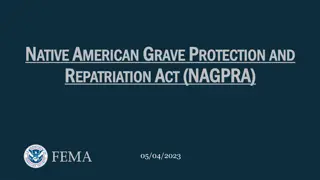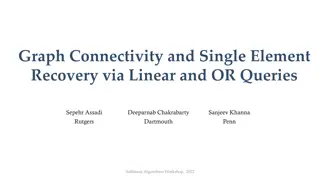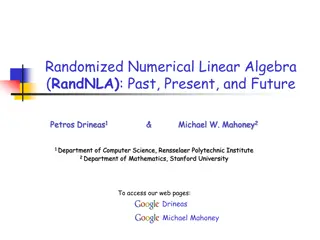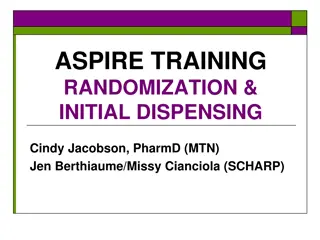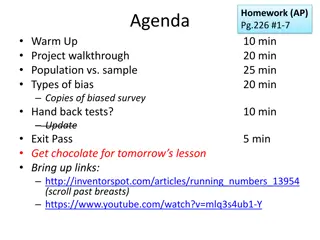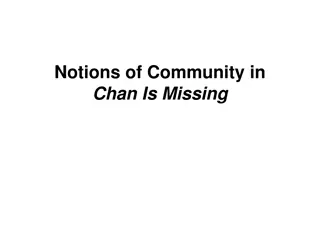Randomization and the American Put: A Comprehensive Overview
The presentation delves into the concept of randomization in relation to the American put option, discussing its application with various distributions and the challenges in finding explicit solutions. It covers the Black-Scholes model, optimal exercise times, critical stock prices, and the implementation of randomization processes. Despite the absence of exact solutions, the speaker explores the process of randomizing parameters and calculating expected values under different distributions.
Download Presentation

Please find below an Image/Link to download the presentation.
The content on the website is provided AS IS for your information and personal use only. It may not be sold, licensed, or shared on other websites without obtaining consent from the author.If you encounter any issues during the download, it is possible that the publisher has removed the file from their server.
You are allowed to download the files provided on this website for personal or commercial use, subject to the condition that they are used lawfully. All files are the property of their respective owners.
The content on the website is provided AS IS for your information and personal use only. It may not be sold, licensed, or shared on other websites without obtaining consent from the author.
E N D
Presentation Transcript
Randomization and the American Put Author: Peter Carr Presenter: Ken Ngo - 467632
Outline 1. American put in Black-Scholes 2. Randomization of the American put with Exponential distribution *on non-dividend-paying stock* 3. Randomization of the American put with Erlang distributed maturity *on non-dividend-paying stock* 4. Implementation 5. Dividend and American options 6. Summary
Brief catch-up - Stopping time: stopping the first time the value of the option agrees with its intrinsic value. Optimal exercise time. - Critical stock price: stock price that makes the investor indifferent between holding an option until expiration, and exercising the option - Exercise boundary:
1. American put in Black-Scholes - Over the option's life [0, T], the economy is described by frictionless markets, no arbitrage, a constant riskless rate r > 0 - No dividends from the underlying stock - Underlying spot price process {St, t E (0, T)} is a geometric Brownian motion with a constant volatility rate > 0 - As the maturity is shortened, the alive American put value falls, while the exercise value remains constant
1. American put in Black-Scholes a b = min(a, b) ??is the first passage time from S to an exercise boundary B(t) with t [0, T]
1. American put in Black-Scholes McKean (1965) proved that the alive American put value and exercise boundary jointly solve a free boundary problem, consisting of the Black-Scholes PDE:
Unfortunately there is no known exact and completely explicit solution to either the optimal stopping problem of Equation (1) or to the free boundary problem of Equation (3) Randomization
Randomization process 1. Randomize a parameter by assuming a plausible distribution for it. 2. Calculate the expected value of the dependent variable in this random parameter setting. 3. Let the variance of the distribution governing the parameter approach zero, holding the mean constant at the fixed parameter value Parameter chosen Initial stock price / Strike price / Initial time / Maturity date
2. Randomization with Exponential distribution ? denote the random maturity time exponentially distributed with scale parameter set to 1/T so mean of maturity of the randomized American put is T ?(1)(S) denote the randomized value of an American put maturing at the first time jump ?1is the unknown optimal exercise boundary time-dependent exercise boundary of a true American put becomes flat when we randomize the maturity
2. Randomization with Exponential distribution Rewrite Equation (7) (6) and (8) imply the following relationship between random and fixed maturity put values D(O, S; t; B) is the initial value of a down-and-out put with fixed maturity t, out barrier B, and rebate K - B
2. Randomization with Exponential distribution Laplace-Carson transform equation 9 PDE to obtain ODE: p(l)(S) is the randomized value of the European put at the first jump time b(l) (S) is the present value of interest received below the critical SI until the first jump time c(l) (S) is the randomized value of the European call at the first jump time
2. Randomization with Exponential distribution Explicitly solve for our first approximation to the exercise boundary ?1 Numerical implementation indicates substantial undervaluation of the put Reduce valuation error by reducing var of distribution If a random variable with an exponential distribution has mean T, then its variance is T^2 Two-parameter distribution for maturity Erlang distribution
3. Randomization with Erlang distribution Split the random maturity into n i.i.d subperiods Assume that each of the n periods is exponentially distributed with parameter Then the maturity date ? is Erlang distributed For mean of maturity to be T then mean of all-subperiods must be Variance now becomes T^2/n
3. Randomization with Erlang distribution The randomized value of the American put with two jumps to maturity: ?2 denotes the length of the second random period prior to maturity and ?2 denotes the unknown optimal exercise boundary over this period
3. Randomization with Erlang distribution Let D(S; T - t, B) denote the time t value of a down-and-out put with fixed maturity T, out barrier B, and which pays a rebate of K - B at the first passage time to B, if this occurs before T, and which pays ?(1) (??) at T otherwise. Then, D(S; T - t, B) satisfies the Black-Scholes PDE
3. Randomization with Erlang distribution The randomized value of the American put maturing after two more jumps of the Poisson process is related to this fixed maturity claim by
3. Randomization with Erlang distribution Laplace-Carson transforms of both sides of the PDE This simpler free boundary problem can be solved analytically
3. Randomization with Erlang distribution Move to the general case ??(?)and ?? jointly solve the following sequence of free boundary problem
3. Randomization with Erlang distribution Closed form solution ?? ?? the first n I + 1 periods ?? boundary over the complementary (?)(?) is the out-of-the-money n (random-length) periods (?) (S) is the present value of interest received below the boundary for (?) (S; 1) is the randomized value call less interest paid above the
3. Randomization with Erlang distribution Explicit solution Since ?(?) in Equation (31) depends on ?? 1 to ?1 , the critical stock prices must be solved recursively,
4. Implementation Denote our approximation [Equation (26)] by a function ?( ) of the mean period length . Richardson extrapolation can be used when the approximation can be adequately described by the first N terms in a Taylor series expansion about the origin:
4. Implementation Value based on the binomial method with 2000 time steps appears to be 8.3378.
5. Dividend and American options We assume that the underlying stock pays dividends continuously until the fixed maturity T. The first term is the present value at t of the constant flow until T, and the residual ?? is the stripped price, reflecting the stripping off of the fixed component of the dividend flow from the stock price.
5.1 Dividend and American put We assume that the risk-neutralized process for the stripped price {??, t (0, T)} is the following geometric Brownian motion:
5.1 Dividend and American put For = 0 and rK, American puts are not exercised early For > 0 and < rK (?)(?) is the randomized value of a short forward position maturing in n - i + ?? 1 periods (?)(?) is the present value of the interest less dividends received when ?? below the boundary for the first n - i + 1 periods ?(?;1) represents the randomized value of a European net interest paid ?? above the boundary over the complementary period
5.1 Dividend and American put Each critical stock price ?? is determined by if = 0 then if not then solve
5.2 Dividend and American call McDonald and Schroder (1990) show put call parity for American options while Carr and Chesney (1997) and Schroeder (1997) prove the corresponding result for critical stock prices
6. Summary The approach is to value options which mature by definition at the nth jump time of a standard Poisson process. Between jump times, the memoryless property of the exponential distribution implies that the option value and exercise boundary are time stationary. As we let the number of jump times approach infinity, keeping the mean maturity fixed, our numerical results indicate that the randomized option value appears to converge smoothly from below to the true American option value. This convergence is dramatically enhanced through the use of Richardson extrapolation.
* Opinion - Incredibly complex as it touches on different distributions and extrapolation method - Closed form solution is clear albeit messy looking - There s no comparison with other methods. - More researches needed to test the efficiency of this method



